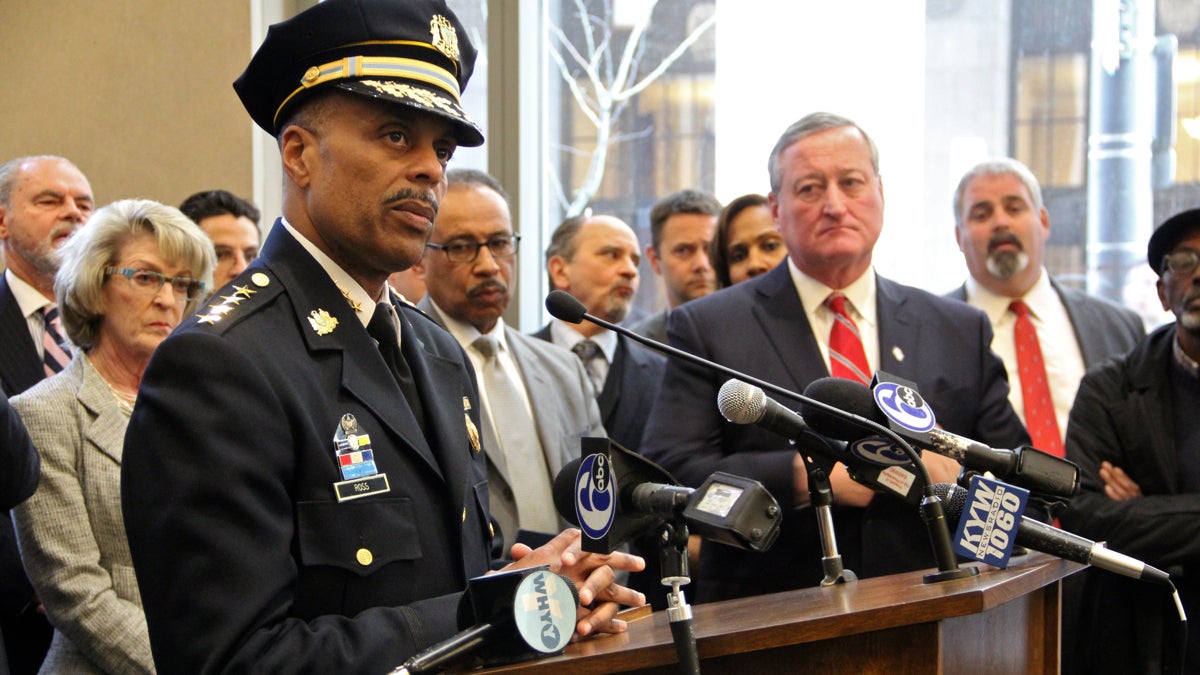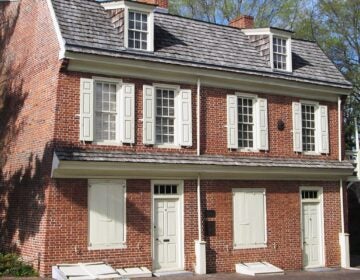$3.5 million grant to help Philly cut inmate population, launch other prison reforms

Philadelphia Police Commissioner Richard Ross answers questions at the Juanita Kidd Stout Center for Criminal Justice about the receipt of the MacArthur Safety and Justice Challenge Grant to support the city's effort to reduce its prison population.(Emma Lee/WHYY)
Philadelphia has won a $3.5 million grant to fund a plan to cut the population in its overcrowded jails by more than a third.
On Tuesday, 7,452 inmates were sitting in Philadelphia’s jails. That’s more than those jails were built to hold, but it’s a vast improvement from 2008 when the population reached over 9,300, forcing many inmates to be confined three to a cell.
It’s something Richard Small has experienced for himself. He was arrested two days after his 18th birthday and charged with aggravated assault. He has spent the last seven years in and out of jail. When you’re the new guy, he says, you get the shaft.
“When you come in last, you gotta sleep in the boat,” Small said, referring to the plastic tubs called “blue boats” the Philadelphia Prison System uses for bedding for a third inmate in cells with only two bunks.
“It feels like you’re sleeping on the floor,” he said. “I would actually prefer the floor to sleeping in the boat because it’s just a false image in your head thinking you have a bed.”
The grant, awarded by the MacArthur Foundation, will help fund a sweeping set of reforms to relieve the overcrowding problem and cut the city’s jail population by 34 percent over the next three years.
About 60 percent of inmates are simply waiting for trial, many of them nonviolent offenders who cannot afford bail or who are being held on detainers for open cases, such as probation violations. Inmates are held for an average of 95 days in Philadelphia, four times the national average.
At a press conference announcing the grant, Deputy District Attorney George Mosey said the goal is to put fewer nonviolent people behind bars for shorter periods of time.
“This is something that we are very committed to because we want to do all that we can to make sure that we employ our limited resources to target the offenders that pose the greatest public safety threat to our community,” Mosey said.
Addressing racial disparities
The plan also aims to deal with glaring racial disparities — 72 percent of Philadelphia inmates are people of color — by providing training to root out bias across the criminal justice system. The Philadelphia Police Department will launch a pilot program in two of its districts to identify first-time, low-level offenders and, rather than arresting them, refer them to drug treatment or other diversionary programs.
“There are some violent people out there that belong in jail, but the vast majority of people can be dealt with in other ways,” said Police Commissioner Richard Ross. “And clearly, we’re in support of that not only from a practical standpoint, but from a fiscal standpoint because it costs money to do what we’ve been doing.”
In Philadelphia, it costs about $100 per day to house just one inmate.
The total reform package will cost just over $6 million, with the city kicking in $2.1 million. Because it did not receive the full $4 million grant it applied for, the city will have to fill the $500,000 funding gap by raising money from private donors or finding additional dollars from city agencies.
To figure out which inmates could be safely released, the city will start using a machine learning-based risk assessment tool: a computer algorithm that uses data on the history of other defendants to determine the likelihood someone will skip mandatory court dates or be arrested again while waiting for trial.
The biggest share of the money, about $2.5 million, will fund expanding alternatives to cash bail, which is used to make sure defendants show up in court.
“Those who present no risk will be released on their own recognizance, while moderate-risk defendants will be supervised to varying degrees,” says the city’s summary report on the plan. That means increased use of electronic monitoring, house arrest and reporting centers for those who are released from jail while they await their day in court.
Under a pilot program, the Defender Association of Philadelphia will hire more attorneys to work with defendants when their bail is being set.
Offering help instead of direct path to jail
Other reforms include beefing up diversionary programs for those charged with selling narcotics such as heroin, as well as releasing some mentally ill inmates within 30 days and expanding treatment and housing services for them.
Public defender Tom Innes said the plan marks a shift in how Philadelphia looks at its criminal justice system.
“We’ve been focusing on re-entry, people coming out of jail,” Innes said. “What we need to do, is those folks who are on their first arrest, their first contact, is to get them the services they might not get until they’re getting out of jail.”
Richard Small, now 24, was invited to Wednesday’s press conference because he took part in a focus group last year with other young, former inmates like himself as part of the MacArthur grant application process. Today, Small is working as an apprentice with the Mural Arts Guild program and is somewhat ambivalent about the city’s reform plans.
“It’s very exciting, but at the same time … it’s nerve-rattling because you think about the fact that some of those people won’t be the model citizens, they will offend,” he said.
Still, Small is hopeful that most of them “will turn themselves around and make a positive impact on themselves and the lives around them.”
As for him, he is confident he’ll never set foot in jail again.
WHYY is your source for fact-based, in-depth journalism and information. As a nonprofit organization, we rely on financial support from readers like you. Please give today.




